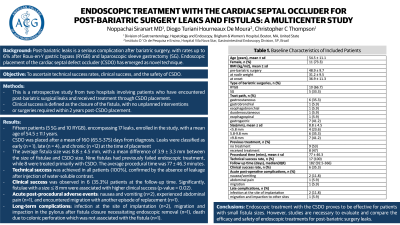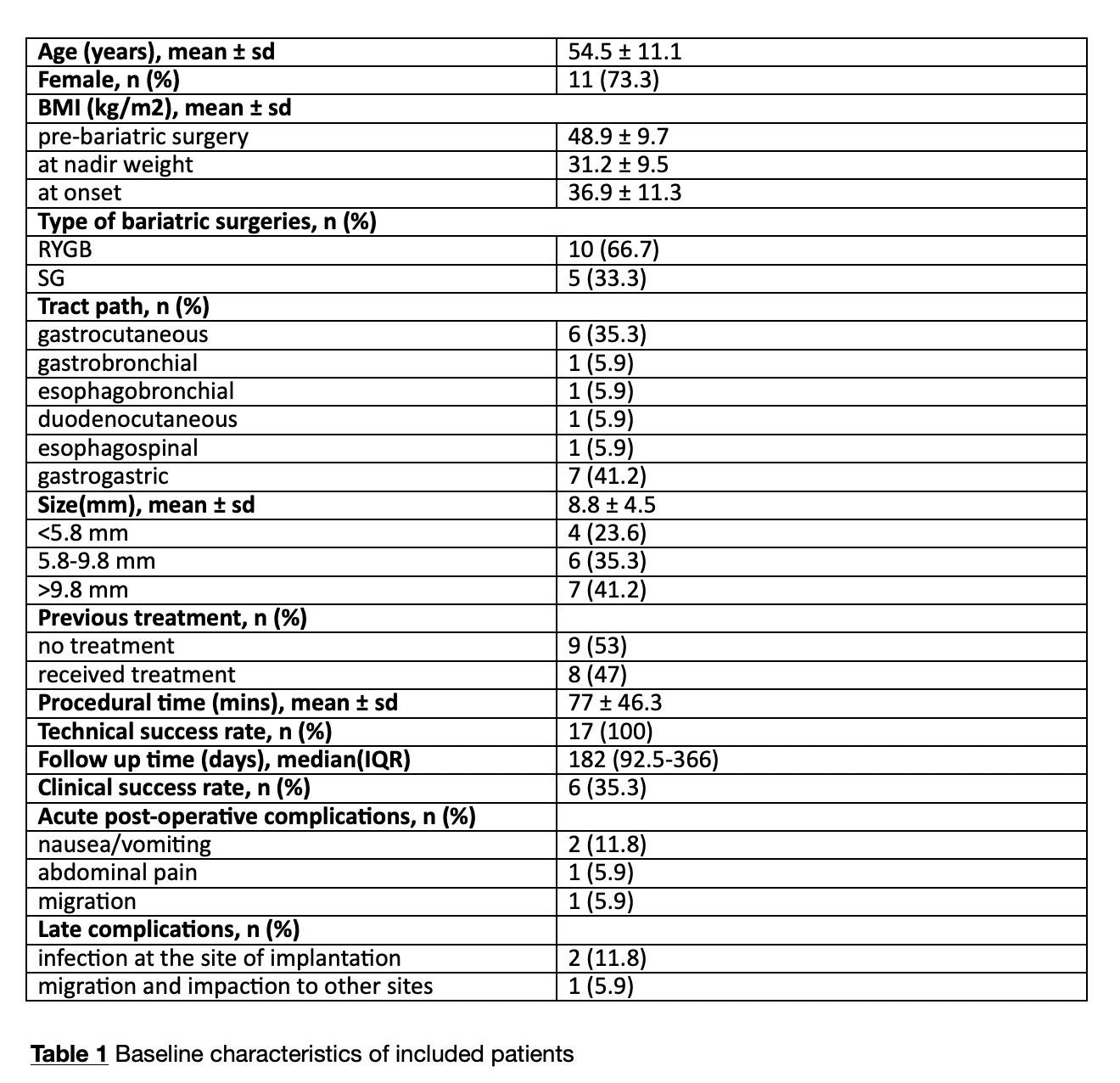Tuesday Poster Session
Category: Interventional Endoscopy
P4491 - Endoscopic Treatment With the Cardiac Septal Occluder for Post-Bariatric Surgery Leaks and Fistulas: A Multicenter Study
Tuesday, October 29, 2024
10:30 AM - 4:00 PM ET
Location: Exhibit Hall E

Has Audio

Noppachai Siranart, MD
Brigham and Women's Hospital
Boston, MA
Presenting Author(s)
Noppachai Siranart, MD1, Diogo Turiani Hourneaux De Moura, MD, PhD2, Christopher C.. Thompson, MD, MSc3
1Brigham and Women's Hospital, Boston, MA; 2Hospital das Clínicas da Faculdade de Medicina da Universidade de Sao Paulo, Sao Paulo, Sao Paulo, Brazil; 3Brigham and Women's Hospital, Harvard Medical School, Boston, MA
Introduction: Post-bariatric leaks is a serious complication after bariatric surgery, with rates up to 6% after Roux-en-Y gastric bypass(RYGB) and laparoscopic sleeve gastrectomy(SG). Endoscopic placement of the cardiac septal defect occluder(CSDO) has emerged as novel technique mainly for chronic defects.
Methods: This is a retrospective study from two hospitals involving patients with post-bariatric surgical leaks and received treatment through CSDO placement. The objective is to ascertain success rates, and the safety of CSDO. Clinical success is defined as the closure of the fistula, with no unplanned interventions/surgeries required within 2 years post-CSDO placement.
Results: Fifteen patients(5 SG and 10 RYGB), encompassing 17 leaks, enrolled in the study, with a mean age of 54.5±11.1 years. The CSDO was placed after a mean of 160(65.5-375) days from diagnosis. Leaks were classified as 1 early, 4 late, and 12 chronic at the time of placement. The average fistula size was 8.8±4.5 mm, with a mean difference of 3.9±3.3 mm between the size of fistulae and CSDO size. Nine fistulas had previously failed endoscopic treatment, while 8 were treated primarily with CSDO. Technical success was achieved in all patients(100%), confirmed by the absence of leakage after injection of water-soluble contrast. Clinical success was observed in 6(35.3%) patients at the follow-up time. Significantly, fistulae with a size≤ 8 mm were associated with higher clinical success (p = 0.02). The average procedural time was 77±46.3 minutes. For acute post-procedural adverse events, 2(11.8%) patients reported nausea and vomiting, 1(5.9%) patient experienced abdominal pain, and 1(5.9%) patient encountered migration with another episode of replacement. Long-term complications included 2 patients with infection at the site of implantation and 1 patient with migration and impaction in the pylorus after fistula closure, necessitating endoscopic removal. Over the 2-year follow-up, only 1 patient was death due to colonic perforation which was not associated with the fistula. For those who did not achieve clinical success with endoscopic treatment, all underwent surgical intervention, resulting in the closure of fistulas in all patients after surgery.
Discussion: Endoscopic treatment with the CSDO proves to be effective for patients with small fistula sizes. However, studies are necessary to evaluate and compare the efficacy and safety of endoscopic treatments for post-bariatric surgery leaks.

Disclosures:
Noppachai Siranart, MD1, Diogo Turiani Hourneaux De Moura, MD, PhD2, Christopher C.. Thompson, MD, MSc3. P4491 - Endoscopic Treatment With the Cardiac Septal Occluder for Post-Bariatric Surgery Leaks and Fistulas: A Multicenter Study, ACG 2024 Annual Scientific Meeting Abstracts. Philadelphia, PA: American College of Gastroenterology.
1Brigham and Women's Hospital, Boston, MA; 2Hospital das Clínicas da Faculdade de Medicina da Universidade de Sao Paulo, Sao Paulo, Sao Paulo, Brazil; 3Brigham and Women's Hospital, Harvard Medical School, Boston, MA
Introduction: Post-bariatric leaks is a serious complication after bariatric surgery, with rates up to 6% after Roux-en-Y gastric bypass(RYGB) and laparoscopic sleeve gastrectomy(SG). Endoscopic placement of the cardiac septal defect occluder(CSDO) has emerged as novel technique mainly for chronic defects.
Methods: This is a retrospective study from two hospitals involving patients with post-bariatric surgical leaks and received treatment through CSDO placement. The objective is to ascertain success rates, and the safety of CSDO. Clinical success is defined as the closure of the fistula, with no unplanned interventions/surgeries required within 2 years post-CSDO placement.
Results: Fifteen patients(5 SG and 10 RYGB), encompassing 17 leaks, enrolled in the study, with a mean age of 54.5±11.1 years. The CSDO was placed after a mean of 160(65.5-375) days from diagnosis. Leaks were classified as 1 early, 4 late, and 12 chronic at the time of placement. The average fistula size was 8.8±4.5 mm, with a mean difference of 3.9±3.3 mm between the size of fistulae and CSDO size. Nine fistulas had previously failed endoscopic treatment, while 8 were treated primarily with CSDO. Technical success was achieved in all patients(100%), confirmed by the absence of leakage after injection of water-soluble contrast. Clinical success was observed in 6(35.3%) patients at the follow-up time. Significantly, fistulae with a size≤ 8 mm were associated with higher clinical success (p = 0.02). The average procedural time was 77±46.3 minutes. For acute post-procedural adverse events, 2(11.8%) patients reported nausea and vomiting, 1(5.9%) patient experienced abdominal pain, and 1(5.9%) patient encountered migration with another episode of replacement. Long-term complications included 2 patients with infection at the site of implantation and 1 patient with migration and impaction in the pylorus after fistula closure, necessitating endoscopic removal. Over the 2-year follow-up, only 1 patient was death due to colonic perforation which was not associated with the fistula. For those who did not achieve clinical success with endoscopic treatment, all underwent surgical intervention, resulting in the closure of fistulas in all patients after surgery.
Discussion: Endoscopic treatment with the CSDO proves to be effective for patients with small fistula sizes. However, studies are necessary to evaluate and compare the efficacy and safety of endoscopic treatments for post-bariatric surgery leaks.

Figure: Figure 1. Baseline characteristics of included patients
Disclosures:
Noppachai Siranart indicated no relevant financial relationships.
Diogo Turiani Hourneaux De Moura indicated no relevant financial relationships.
Christopher Thompson: Apollo Endosurgery – Consultant, Grant/Research Support. Bariendo – Consultant, Founder, Owner/Ownership Interest. Boston Scientific – Consultant, Grant/Research Support. Endoquest Robotics – Advisory Committee/Board Member, Consultant, Grant/Research Support. Endosim – Royalties. Enterasense Ltd. – Advisory Committee/Board Member, Consultant, Founder, Owner/Ownership Interest, Stock Options. EnVision Endoscopy – Advisory Committee/Board Member, Consultant, Founder, Owner/Ownership Interest, Stock Options. ERBE – Grant/Research Support. Fractyl – Consultant, Grant/Research Support, Stock Options. Fujifilm – Grant/Research Support. GI Dynamics – Consultant, Grant/Research Support. GI Windows – Advisory Committee/Board Member, Consultant, Founder, Owner/Ownership Interest, Royalties, Stock Options. Lumendi – Grant/Research Support. Medtronic – Advisory Committee/Board Member, Consultant. Olympus – Consultant, Grant/Research Support. USGI Medical – Advisory Committee/Board Member, Consultant, Grant/Research Support. Xenter – Advisory Committee/Board Member, Consultant.
Noppachai Siranart, MD1, Diogo Turiani Hourneaux De Moura, MD, PhD2, Christopher C.. Thompson, MD, MSc3. P4491 - Endoscopic Treatment With the Cardiac Septal Occluder for Post-Bariatric Surgery Leaks and Fistulas: A Multicenter Study, ACG 2024 Annual Scientific Meeting Abstracts. Philadelphia, PA: American College of Gastroenterology.
